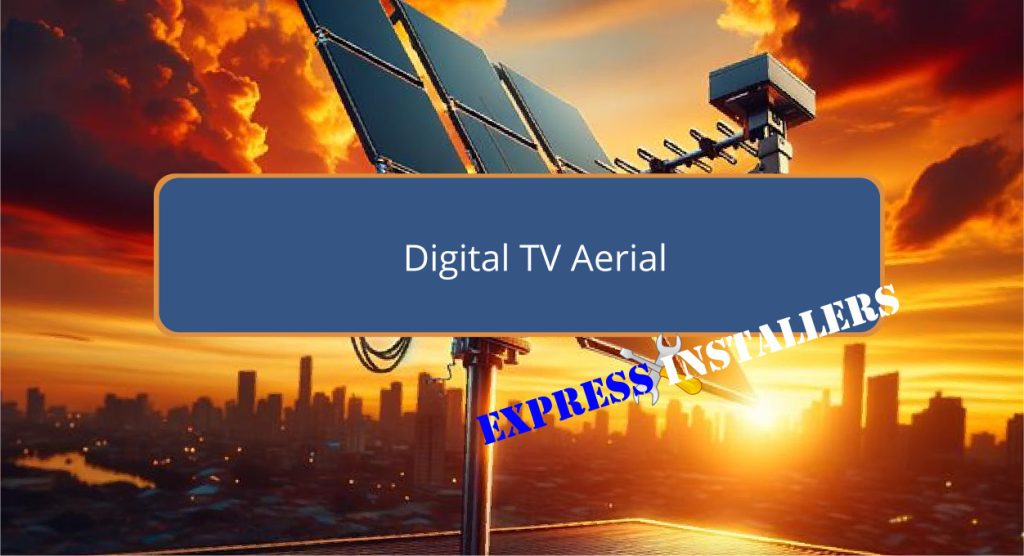
A digital TV aerial, essential for enhanced signal reception, comes in various types, including high gain, log periodic, and omni-directional aerials.
High gain aerials are ideal for areas with medium to weak signal strengths, requiring precise alignment to function effectively.
Log periodic aerials, on the other hand, capture a broad range of frequencies and are less directional. Omni-directional aerials accept signals from multiple directions, optimising versatility.
Installation requires positioning the aerial high, using quality coaxial cable, and ensuring firm mounting to prevent weather-induced disturbances.
Correct installation and maintenance greatly influence performance, and further exploration can reveal additional insights into achieving the best setup.
Quick Summary
- Digital TV aerials, like high gain and log periodic, enhance reception in areas with varied signal strengths.
- Proper installation, including high placement and alignment towards transmitters near you, is crucial for optimal signal reception.
- Use of quality coaxial cables and secure mounting protects against signal loss and weather-related damages.
- Signal boosters and 3G/4G filters can be integrated to amplify and clarify the signal in weak reception areas.
- Choosing the right aerial depends on local signal strength, with heavier options needed for weaker signal regions.
Types of Digital TV Aerials
Digital TV aerials are classified into several types, including high gain, log periodic, and omni-directional models, each designed to address specific reception challenges and signal environments.
High gain aerials are essential in areas with medium to weak signal strength, optimising signal amplification to enhance reception quality effectively.
They require precise alignment to the nearest transmitter for maximum efficiency, highlighting the importance of professional aerial maintenance to prevent degradation in performance over time.
Log periodic aerials, with their wide frequency range, are adept at capturing multiple channel signals, requiring periodic checks to guarantee sustained performance across all frequencies.
Omni-directional aerials receive signals from multiple directions, simplifying setup but still benefit from regular maintenance to make sure they remain free from physical obstructions and wear.
Installation Tips for Aerials
Having discussed the different types of digital TV aerials, we now focus on effective installation techniques to guarantee peak performance.
Primarily, positioning the aerial as high as possible is essential to minimise obstructions and interference.
Using high-quality coaxial cable enhances the connection between the aerial and TV, optimising signal strength.
Proper alignment towards the nearest transmitter is key for receiving the best possible reception. Additionally, avoid proximity to electronic devices that could generate interference.
Secure mounting of the aerial is important to withstand adverse weather conditions and prevent shifting.
Incorporate troubleshooting tips by regularly checking connections and cable integrity.
A maintenance checklist should include periodic verification of aerial positioning and stability, ensuring sustained performance.
Enhancing Signal Reception

To enhance signal reception in digital TV aerial setups, employing a high gain TV aerial is advised for areas with medium to weak signal strength.
Signal boosters can amplify the received signals, mitigating issues related to signal loss, while signal splitters facilitate distribution without significant degradation.
Addressing signal interference is important; the integration of 3G and 4G block filters is effective in reducing disruptions from mobile phones, thereby stabilising signal quality.
Additionally, precise antenna positioning and alignment towards the nearest TV transmitters are essential strategies to optimise reception.
Accessories such as the Labgear TV Aerial Chimney Fixing Kit can also play an important role in securing the aerial, minimising potential misalignments and ensuring sustained signal integrity.
Choosing the Right Aerial
Selecting the appropriate aerial requires careful consideration of local signal strength and specific broadcasting needs to guarantee peak television reception.
For regions with robust signal strength, a small, lightweight aerial may suffice.
Conversely, areas plagued by medium to weak signals necessitate a more substantial solution, such as the Labgear Double Yagi High Gain TV Aerial or the Televes DAT HD.
Aerial positioning is critical; it should be mounted at the best height and direction to mitigate loss due to weather interference.
Additionally, integrating signal boosters can enhance reception quality.
Proper cable management and accessories like the Labgear TV Aerial Stand-Off Bracket ensure stability and longevity of the installation, safeguarding against environmental impacts.
Frequently Asked Questions
Do You Need a Special Aerial for Digital TV?
Yes, a specialised aerial is often required for best digital TV reception, particularly considering signal strength and area. Installation costs vary based on aerial type and geographical factors affecting signal accessibility.
What Is Best Aerial for Digital?
The best aerial choice depends on signal strength in your area. For weak to medium signals, consider high-gain options like the Labgear Double Yagi, while the Triax TX10 suits strong signal conditions, balancing installation costs and signal quality.
Are Digital TV Aerials Any Good?
Digital TV aerials, designed for peak signal strength, generally offer excellent performance. However, the effectiveness and installation costs can vary based on the specific area’s signal conditions and the chosen aerial model.
What Is the Difference Between a Normal Aerial and a Digital Aerial?
The difference lies in signal quality; digital aerials enhance reception, reducing interference for clearer images. Although potentially higher in installation costs, they provide superior access to a broader range of digital broadcasting services.
Conclusion
In summary, the selection of an appropriate digital TV aerial has a profound impact on the quality of signal reception.
Factors such as type, location, and installation intricacies play crucial roles.
By carefully considering these elements, excellent reception can be achieved, thereby enhancing the overall viewing experience.
It is essential that installations adhere to technical guidelines to avoid common pitfalls associated with signal degradation.
Therefore, informed decisions in choosing and installing digital TV aerials are vital for sustained signal integrity and performance.
